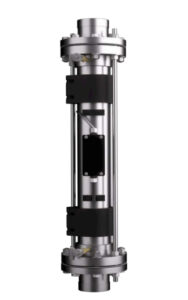Design Considerations When Using Copper-Silver Ionization (CSI) for the Control of Legionella
What are the design considerations for copper-silver ionization Legionella control systems? Below are the major areas to consider.
 pH, Conductivity & Temperature with CSI:
pH, Conductivity & Temperature with CSI:
- pH Influence: The effectiveness of copper and silver ions is influenced by pH but does not affect its ability to disinfect. While silver acts as the primary disinfectant, copper’s solubility decreases as pH rises. Thus, keeping the pH in a neutral range is preferred for optimal ionization. However, copper silver ionization should perform adequately even in higher pH applications and has been shown to work at pH above 9, making it a good choice for high pH applications.
- Conductivity: This is a major design consideration. Ideally, conductivity in the water should be maintained within a range of 80–1200 µS. Low conductivity makes it difficult to pass current and achieve the desired amperage for ionization. In contrast, if conductivity is too high, cell spacing or surface area might need adjustment to maintain efficiency.
- Temperature: Temperature does not affect CSI as it does for oxidizers like chlorine, monochloramine and chlorine dioxide, where the oxidant dissipates much more quickly the hotter the water making it a great application for hot water loops.
Ion Concentrations:
- Copper: Although copper contributes to Legionella control, silver is the more important element. Copper concentration ideally would be .2 ppm and needs to be at least 0.1 ppm. Lower levels of copper are less concerning than low silver levels.
- Silver: The target concentration for silver is typically between 30–80 ppb, with a minimum of 30 ppb being a consistent and effective level. Keeping silver levels steady is crucial to ensuring consistent disinfection.
Corrosion Considerations:
- Galvanic Corrosion: While galvanic corrosion is generally not a direct issue for CSI, deposition corrosion could arise if copper deposits build up inside the piping.
- Pipe Material: The oxide layer inside copper pipes acts as a barrier to corrosion. Pipes identified as galvanized may no longer have the galvanized coating on the inside because the zinc layer may have eroded, reducing chances of reaction from CSI.
Stray Currents and Flow Cells:
- Stray Current: Stray electrical currents can occur due to the flow cell construction, particularly if materials like aluminum are part of the system. This can create inefficiencies and potential wear in the system. Rarely are issues that are considered to result from CSI systems near the cells, which doesn’t support the stray current argument for being an issue.
Scaling Issues:
- Hard Water: Scaling becomes more prominent when hard water flows through the ionization cell. Regular maintenance or design considerations to mitigate scale buildup (e.g., water softeners or surface area adjustments) should be factored in.
Flow Rate and System Sizing:
- Sizing: CSI systems are often sized based on the flow rate of the water being treated. Voltage and surface area adjustments are made in response to changes in water flow, ensuring the system remains effective over a range of conditions.
Effect of Chlorides and Sulfates:
- Chlorides and sulfates don’t have a large impact on CSI.
Copper-silver ionization (CSI) can be an effective tool for controlling Legionella. However, the proper design of a copper-silver ionization requires expertise of an independent Legionella expert such as Legionella Control Systems. Contact us to speak with a certified engineer who can answer your questions and help you create the best Legionella remediation or mitigation system for your facility and budget.
Contact the Legionella experts at info@legionellacontrolsystems.com or 888-416-8626 right now.




 pH, Conductivity & Temperature with CSI:
pH, Conductivity & Temperature with CSI:


